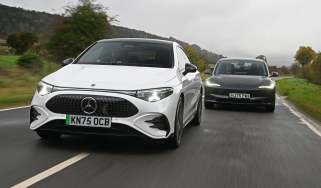New Peugeot Hypersquare review: the future of the steering wheel?
We get an early taste of Peugeot's new revolutionary Hypersquare steering wheel
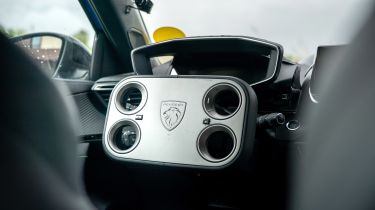
Peugeot’s been here before. Well, not with a steer-by-wire (SBW) system as such, but introducing a new form of steering wheel to customers. It did this with the controversial i-Cockpit layout around 12 years ago, and faced some fierce criticism for the combination of a small low-set steering wheel and high-mounted dials.
But the engineers at Peugeot I spoke to don’t seem fazed by this new challenge – after all, the company hasn’t exactly withered since the i-Cockpit’s inception. If anything, the notion of a small steering wheel mounted below the instrument cluster is something we’re now seeing across the industry; and there’s a good chance the Peugeot Hypersquare might well be similarly ahead of the game when it’s introduced on the all-new Peugeot 208 supermini in 2026.
What is Hypersquare?
Hypersquare isn’t just a new steering wheel; a whole new steer-by-wire experience has been designed alongside it. SBW is a set-up that removes the physical connection between the wheels and steering wheel, and replaces it with a digitised system. This has actuators and sensors on the steering wheel and front axle, and electronics do the talking between them so that everything feels natural.
Peugeot isn’t the first to do this. Mercedes is on the cusp of revealing its own SBW system, and Lexus is already there with the updated RZ. Tesla, perhaps most controversially, brought out its system on the Cybertruck, but it remains an unlikely proposition for Europe. What all of those cars have in common, though, is their position at the top end of the market. In complete contrast, Peugeot’s first fitment of this new technology will be in something significantly smaller and more affordable.
Used - available now

2024 Vauxhall
Grandland
15,548 milesManualPetrol1.2L
Cash £17,500
2023 Tesla
Model Y
39,449 milesAutomaticElectric
Cash £24,397
2024 Volkswagen
ID.5
22,034 milesAutomaticElectric
Cash £21,197
2022 Renault
Arkana
23,429 milesAutomaticPetrol1.3L
Cash £17,697If you can't wait for the new 208 to arrive, check out our great deals on the current model via our Buy a Car service. You can get your hands on a new Peugeot 208 for as little as £17,000.
What are the benefits of Hypersquare?
To start with, a steer-by-wire system makes it significantly easier to package the front end of a car, because there’s no need to fit a big rod leading between the steering wheel and front axle. In fact, engineers need to package in two big rods, because they have to factor in the ability for a car to be built in left or right-hand drive. By removing this otherwise immovable object, engineers have more space to fit a whole range of things around the powertrain, such as air-conditioning and more relevant electrical equipment.
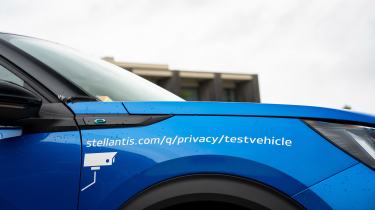
We’re told of other, more direct benefits to drivers, too, such as the fact that noise and vibrations can be effectively eliminated from the wheel. Plus Peugeot can engineer in a steering ratio that varies depending on the car’s speed, altering the amount the car steers when the wheel is turned. This means Peugeot can limit the steering wheel to turning through a shockingly small 170 degrees, even at full lock, so drivers need never remove their hands from the wheel. However, the degree of response used at low speed would make the car too twitchy at motorway speeds, so the ratio is lowered in line with the car’s speed, making for a much more relaxing experience.
Is it a wheel? Or a drinks tray?
But before we get in and drive using the Hypersquare, we first have to come to terms with the fascinating wheel – if you can call it a wheel. Unlike a Cybertruck, which essentially has just a chopped-down steering wheel, or the Lexus and its aeroplane-style ‘yoke’, Peugeot has designed something that doesn’t really look like a steering device at all. Yet when you hold it, it feels remarkably natural, thanks in large part to the highly sculpted back section, and those four symmetrical openings.
However, this brings up issue number one when speaking to Peugeot’s specialists. While you’re not really supposed to, many drivers find themselves not holding a steering wheel at the usual 10 and 2 position when driving over long distances. But with a control like this, you’re effectively forced to hold it in only one position.
Peugeot told us the car it’ll be used in will have an interior designed around making holding the wheel as comfortable as possible. For example, it will raise the areas where a driver might rest their elbows, but it’s hard to gauge considering our test car is a current-generation e-2008.
It’s also intended to work with a different cockpit design, where there will be only two stalks behind the steering wheel: indicators and wipers on one side, and a gear selector on the other. This will all be powered by the new Stellantisbrain, a software-defined-vehicle architecture that’s on the cusp of production, just as similar set-ups are from VW, Mercedes and BMW.
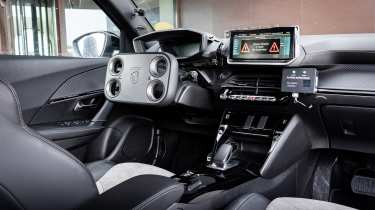
Any other things to keep in mind?
The other potential block to overcome – and the element we feel will cause the most controversy – is that the sense of connection between driver and car has been eroded thanks to that changing steering ratio. This will be particularly apparent when quickly decelerating from a high speed to a low one and then making a turning manoeuvre, such as peeling off a fast A-road.
Even after we’d had a couple of attempts, the amount of steering lock required changes so dramatically that we found ourselves steering too much, then realising we were turning in too quickly, and rapidly unfurling a bit of lock. It’s a jerky process, and although drivers will get used to it after some acclimatisation, we wonder how it’ll feel to customers on a short test drive, and without an engineer in the passenger seat talking them through it.
There’s another consideration, too, and that’s the changing ratio as you accelerate or decelerate, as you might do when entering or exiting a motorway. If you maintain the same lock while accelerating around a long bend, the car will feel like it’s understeering wide as the ratio slows down. We found this quite disconcerting, and while it can be countered by adding more steering lock, it’s not a smooth or natural process to try and guess the rate at which the ratio is lowering.
This isn’t to say Peugeot is unaware of these compromises in feel and feedback, which is why the system has been in development for such a long time – since 2018, in fact. To combat this, Peugeot has created a feedback system to generate artificial feel in the Hypersquare. Mounted to the back of the wheel is a feedback generator, or haptic engine, which doesn’t ‘synthesise’ feel but reproduces inputs from a sensor at the base of the steering in real time. This helps, but doesn’t completely instill the sense of confidence a ‘normal’ electric power steering system would.
What does it actually feel like?
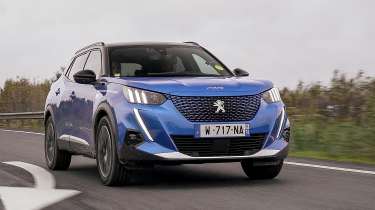
On our first go with the system, the steering response and feel were very good. And with so few turns lock to lock, it made parallel parking a much less hectic affair. But we wonder how natural some people will find the experience, which is especially important given that there’s no more important touchpoint in a modern car.
We asked engineers whether this technology will be aimed at sporting models to increase their agility, or luxury models to heighten the sense of isolation from the road, but they were adamant that this isn’t a niche technology. Instead, they want to democratise it across all of the company’s models, much like Peugeot’s EV strategy of in effect offering all of its models with or without an electric powertrain.
There is also a range of safeguards in case the system has any major faults, with back-up electronics across all of the main elements, including a secondary ‘virtual steering rack’ that’s mounted in a completely separate housing. If all else fails, the car’s system will be able to autonomously pull you to the side of the road.
Did I like it? Not initially. I found the system had benefits, but I lacked confidence in how precise my steering inputs were, especially as the car’s speed fluctuated. I do think, however, that this is a natural step forward in automotive engineering, and as we all become more accustomed to it and other systems, it should fall to hand as easily as an iPhone did when switching from a brick phone.
I also think Peugeot needs to be congratulated on how brave it’s been in such a sensitive area of a car’s driving experience. I love the way Hypersquare looks, and can’t wait to see how it works in the context of a new era of Peugeot interior design. However, there’s another big difference between Hypersquare and the i-Cockpit. Peugeot won’t force anyone into driving with its new Hypersquare, and will offer it alongside the option of a standard wheel for the foreseeable future. So if you don’t like it, it’s no big deal. Smart move.
Did you know you can sell your car through Auto Express? We’ll help you get a great price and find a great deal on a new car, too.




